Article Information
- WenTao Du, ShiChang Kang, Xiang Qin, XiaoQing Cui, WeiJun Sun . 2016.
- Atmospheric insight to climatic signals of δ18O in a Laohugou ice core in the northeastern Tibetan Plateau during 1960-2006
- Sciences in Cold and Arid Regions, 8(5): 367-377
- http://dx.doi.org/10.3724/SP.J.1226.2016.00367
Article History
- Received: June 10, 2016
- Accepted: August 17, 2016
2. CAS Center for Excellence in Tibetan Plateau Earth Sciences, Beijing 100101, China;
3. University of Chinese Academy of Sciences, Beijing 100049, China;
4. College of Population, Resources and Environment, Shandong Normal University, Jinan, Shandong 250014, China
Ice cores with high resolution and good fidelity are usually used to provide valuable climate change information at higher elevations that better reflects the free atmosphere instead of local human-induced effects. Thus, they pose an interesting question concerning the rate of warming in areas of higher elevation. Oxygen isotope (δ18O) in ice core is regarded as a reliable proxy of air temperature in paleoclimate reconstructions at the global scale, especially in the Tibetan Plateau (TP) (Rosen et al., 2014; Takeuchi et al., 2014; Landais et al., 2015; Zhang et al., 2016), which encompasses the largest number of glaciers outside the polar regions and acts both as a trigger and as a magnifier of global climate change (Alley et al., 1993; Kang et al., 2010; Yao et al., 2012). Numerous studies on climate reconstructions using ice cores in the TP have been performed since the 1980s (Figure 1) (e.g., Yao et al., 1996; Hou et al., 2002; Tian et al., 2003; Wang et al., 2003; Thompson et al., 2006; Kang et al., 2002, 2007, 2011; Zhang et al., 2016). Stable isotopes in ice cores have been proven to reveal the changes of air temperature over the whole TP, even though they behaved amount effect in seasonal scale but matched well with air temperature changes in long term in southern TP, which indicated that intense monsoons could weaken the relationship between air temperature and δ18O (Tian et al., 2003; Kang et al., 2007; Yao et al., 2013). However, spatial biases still hold and need to be further investigated via enrichment of more ice records in different regions due to the diversity of climatic rangeabilities and spinodals in ice cores. In the northeastern TP, the only investigation of ice cores at high elevations was conducted on the Dunde ice core in the 1980s (Yao and Thompson, 1991), but the core did not record the dramatic climate warming and undergo the interactions between the westerlies and the summer monsoon (Qian et al., 2001; Liang et al., 2010). The δ18O ice records in the northeastern TP need to be updated and further investigated to determine their validity as climate proxies and their response to prominent climate warming, especially after the 1990s because it is concerned whether ice records have absence (Kang et al., 2015).
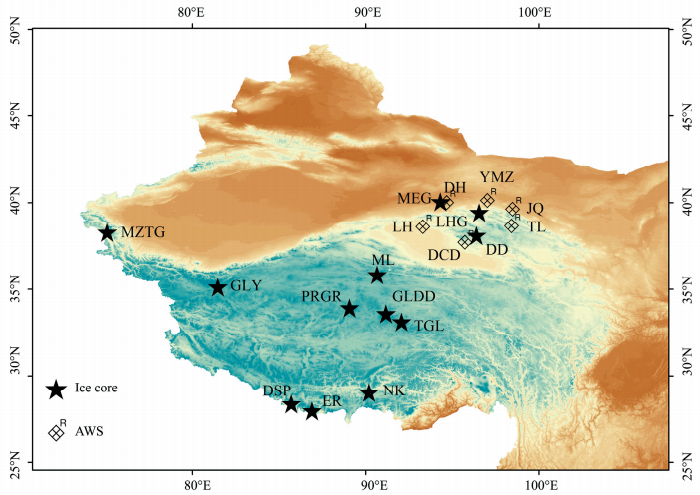
|
|
Figure 1 Sketch of ice core drilling sites in the Tibetan Plateau and adjacent meteorological stations.
DH: Dunhuang; YMZ: Yumenzhen; JQ: Jiuquan; TL: Tuole; LH: Lenghu; DCD: Dachaidan; LHG: Laohugou; DD: Dunde; ML: Malan; MZTG: Muztag; GLY: Guliya; PRGR: Puruogangri; GLDD: Geladiandong; TGL: Tanggula; NK: Noijinkangsang; DSP: Dasuopu; ER: Far East Rongbuk; MEG: Miaoergou |
In this study the δ18O record of the Laohugou (LHG) ice core in the northeastern TP was reconstructed covering the period 1960–2006. Its variations, periodicity, and the occurrence of abrupt events were also analyzed. Furthermore, adjacent meteorological temperatures and 500 hPa temperature reanalysis data were also collected to identify the climatic signals. Various climatic variables from the National Centers for Environmental Prediction/National Center for Atmospheric Research (NCEP/NCAR) were chosen to investigate the underlying mechanisms by means of their relationships with the atmospheric parameters. This research aims to establish a basis for the study of paleotemperatures from deep ice cores.
2 Methodology and dataIn June 2006, a 20.12-m ice core was extracted from the LHG Glacier No. 12 in the northeastern TP, which is the headwater region of the inland Shule River and adjusts the water resources of the Hexi Corridor (Figure 1). The LHG Glacier No. 12 is well suited to study ice cores because of its low temperature and well-preserved snow and ice accumulation. The ice core was annually dated covering the period of 1960–2006, the methods of which were described in Cui et al. (2011) and Dong et al. (2013). To better interpret the δ18O variations in the ice core, stable isotopes from precipitation and snow pits were also collected and compared with meteorological data to identify their climatic significance, which showed an apparent positive relationship between the δ18O and temperature, and highlighted a " temperature effect" (Hou, 2011; Cui et al., 2014). This indicated that it should be possible to reconstruct historic temperatures from the LHG ice core.
To investigate the climatic significance of the δ18O record in the LHG ice core, air temperature records from the adjacent meteorological stations (Figure 1) including Yumenzhen (YMZ), Tuole (TL), Jiuquan (JQ), Dunhuang (DH), Lenghu (LH), and Dachaidan (DCD) were collected from the National Meteorological Information Center (http://ncc.cma.gov.cn/cn/), China Meteorological Administration. The quality of observational data in China meets the World Meteorological Organization's standards. In addition, in-situ contemporaneous temperatures from the drilling site (5, 040 m a.s.l.) and base camp (4, 200 m a.s.l.) were compared for further evaluation of the homogeneity, and both series showed agreement (r =0.998, p < 0.001) (Figure 2). Therefore, the reconstructed temperatures (Du et al., 2012) at the base camp during 1960–2006, based on interpolation, could be used to represent the air temperature at the drilling site for comparison with the δ18O records.
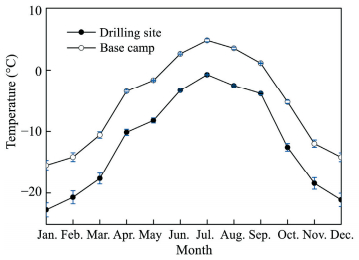
|
| Figure 2 Comparison of air temperature between drilling site and base camp. Error bars represent the standard deviation of the mean at a confidence interval of 95% |
Atmospheric circulation is considered one of the principal physical processes responsible for long-term interannual and interseasonal climate variability, particularly on the regional scale (Vicente et al., 2009). The NCEP/NCAR reanalysis data were provided by the National Oceanic and Atmospheric Administration/Earth System Research Laboratory/Physical Sciences Division, Boulder, CO, USA (http://www.cdc.noaa.gov/). The datasets covered the period 1948–present at a spatial resolution of 2.5°×2.5°, and they were initialized with a variety of weather observations, including data from ships, planes, and satellites. To minimize potential dating errors and to facilitate comparison, 3-year running averages were used for each of the δ18O, instrumental, and reanalysis datasets.
3 Results 3.1 Variations of δ18O in the LHG ice coreThe annual δ18O record of the LHG ice core (Figure 3a) showed a relatively large span of 6‰, from −10.42‰ at the 11.30-m (1967) depth to −16.37‰ at the 0.27-m depth (1969), and its median and mean values were −13.70‰ and −13.72±1.371‰, respectively. The δ18O values decreased distinctly until the late 1960s, followed by an increasing trend with a peak in the late 1970s. No statistically significant linear trend in annual δ18O was present throughout the 1980s (although it had strong undulation), but a dramatic increase of δ18O occurred during 1992–2006 (slope=0.22; r =0.72; p < 0.001), becoming higher than the average annual δ18O value during 1960–1991. The actual time of that occurrence was identified as 1992 by Mann-Kendall analysis (Figure 3b), consistent with the time of significant warming in the TP, the Qilian Mountains (Yao et al., 2006; Jia et al., 2008), and in the latest results of the IPCC-AR5, which indicated that the last decade has been the warmest 10 years over the past 1, 400 years (Vaughan et al., 2013). In addition, the highest annual δ18O value occurred in 1967, which coincided with a climatic shift in the Northern Hemisphere during the mid-1960s (Yan et al., 1990; Subbaramayya and Naidu, 1992), indicating that an abrupt climatic event and significant warming at the regional or hemispherical scales could be captured reliably by the LHG ice core.
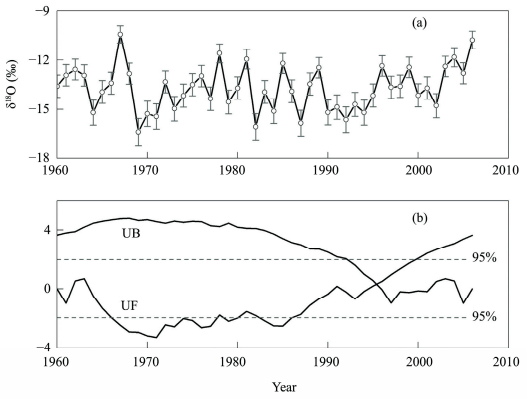
|
| Figure 3 δ18O variations in LHG ice core and Mann-Kendall analysis. Error bars represent the standard deviation of mean at a confidence interval of 95% |
Power spectrum analysis is an adaptive method for diagnosing significant cycles of climate change time series, performing statistical signal processing and extracting signals from noisy, nonlinear, and non-stationary data. A quasi three-year period of variation (p < 0.05; not shown) was identified in the δ18O variations of the LHG ice core, corresponding with the periods of the North Atlantic Oscillation (NAO) and the El Nino-Southern Oscillation (ENSO), which were also detected in the Malan ice core in the northern TP (Wang et al., 2003), the Geladiandong ice core in the central TP (Kang et al., 2007; Zhang et al., 2016), the Noijin Kangsang ice core in the southern TP (Zhao et al., 2012; Gao et al., 2016), and the Miaoergou ice core in the Tien Shan Mountains (Zhang et al., 2012), indicating that the NAO and ENSO could affect δ18O variations all over the TP.
3.2 Comparison with instrumental temperaturesIt might be more appropriate to compare δ18O variations with air temperature at 500 hPa than with instrumental temperatures recorded at low-elevation meteorological stations (Wang et al., 2003) because they are considered more representative of free-air temperature conditions. In this paper, the 500 hPa air temperatures at annual and interdecadal time scales from NCAR/NCEP data for the period 1960–2006 were chosen to evaluate the climatic signals of δ18O in the LHG ice core. The δ18O variations in the LHG ice core had a significant correlation with summer temperatures in boreal China (r=0.45, n=47, p < 0.002) (not shown). In comparisons with temperature records at adjacent meteorological stations and reconstructed temperatures in the LHG region, the δ18O series had significant positive relationships, indicating that the δ18O record could be considered a reliable representation of regional temperatures.
To investigate how increasing isotope ratios in the LHG ice core reflect rising temperatures, the annual average ratios were compared with the average May–September (MJJAS) temperatures reconstructed at the base camp, and a regression analysis revealed a close relationship: δ18O=0.6781T–14.578 (r=0.4, n=45, p < 0.005), which presents a quantitative relationship that a 1‰ change in δ18O is equal to a 1.47 ℃ change in temperature. Thus, the warm season temperature anomaly during 1960–2006 was reconstructed by utilizing the ice core δ18O record (Figure 4), consistent with the trend of temperature anomalies of adjacent stations, the Qilian Mountains, the TP, China, and the Global scale (Figure 4). The cold period in the 1960s, the slowly ascending temperature trend in the 1980s, and the rapid warming trend in the 1990s were highly consistent with each other. These consistencies indicated that the δ18O variation in the LHG ice core at 5, 040 m a.s.l. was a good proxy for air temperature change. Since 2000, the reconstructed temperature at high elevation (5, 040 m a.s.l.) is still higher increasing, in accordance with Qilian Mountains and TP. In view of the cooling in the 1960s, the increasing rates of temperature series were calculated starting from 1970, showing that reconstructed temperature from the ice core warmed at the rate of 0.48 ℃/decade, which was much higher than at the other six stations (Table 1) as well as in the Qilian Mountains (0.41 ℃/decade), the TP (0.29 ℃/decade), China (0.35 ℃/decade), and the global scale (0.29 ℃/decade). After the 1990s, the warming rates became higher than ever before at these sites and scales, being 2.1, 0.66, 0.58, 0.47, and 0.36 ℃/decade, respectively. Meanwhile, the fluctuations of the reconstructed temperature from the LHG δ18O record were more dramatic than in other records (Figure 4) because climate change at the high-elevation regions in the TP might be more sensitive than that of the lower elevations due to specific topographies (Molnar et al., 2010) and different land surfaces. The land cover types in alpine regions, especially snow/ice, are more complex than in plains areas, and they can yield drastic variations of albedo in comparison with a single land cover type of plains (Cui and Graf, 2009), which could govern the energy budget between the air and the snow/ice, and greatly change the near-surface air temperature (Sun et al., 2012; Sun et al., 2014). Moreover, the complex terrain of an alpine region can have a significant effect on the regional climate through dynamic and thermal processes (Wu and Zhang, 1998; Kattel et al., 2013). For example, alpine terrain can have complex vertical structures, even in relatively narrow areas, especially during the winter half of the year (Daly, 2006; Stahl et al., 2006).
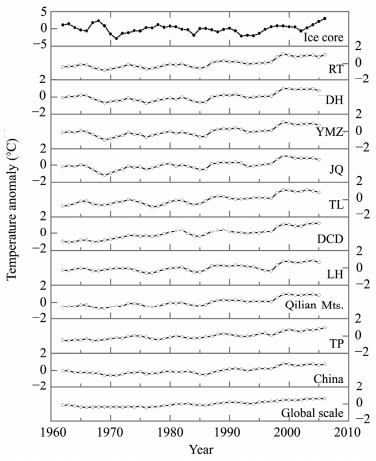
|
| Figure 4 Comparisons of summer temperature anomalies reconstructed by the ice core δ18O records and those of adjacent stations, the Qilian Mountains, Tibetan Plateau, China, and the global scale during 1970–2006. RT: Reconstructed temperature in the LHG region by interpolation; DH: Dunhuang; YMZ: Yumenzhen; JQ: Jiuquan; TL: Tuole; LH: Lenghu; DCD: Dachaidan; TP: Tibetan Plateau |
| Period | RT | DH | YMZ | JQ | TL | LH | DCD | Qilian Mts. | TP | China | Global scale |
| After 1970s | 0.48** | 0.41** | 0.42** | 0.39** | 0.45** | 0.28 | 0.46** | 0.41** | 0.29 | 0.35** | 0.29 |
| After 1990s | 0.73*** | 0.71*** | 0.62** | 0.61** | 0.8*** | 0.52** | 0.78*** | 0.66** | 0.58** | 0.47** | 0.36 |
| * is at the confidence level of 90%; ** is at the confidence level of 95%, *** is at the confidence level of 99.9%. RT: Reconstructed temperatures in the LHG region by interpolation; DH: Dunhuang; YMZ: Yumenzhen; JQ: Jiuquan; TL: Tuole; LH: Lenghu; DCD: Dachaidan; TP: Tibetan Plateau. | |||||||||||
When we analyzed the correlations of sequential data of both the temperature and the δ18O record at various time intervals, the most distinct positive correlations occurred in the summer June–August (JJA) temperature during 1960–1984 (r=0.722, n=22, p < 0.001 and the warm season (MJJAS) temperature during 1985–2006 (r=0.775, n=23, p < 0.001) respectively (Table 1). These might be associated with ice deposition and increasing precipitation because consecutive variations of air temperature were noted for sporadic precipitation events (Yao et al., 1996; Tian et al., 2003), and they were influenced by an increased ratio of summer precipitation in the whole year (Sun et al., 2012; You et al., 2012, 2015) owing to global warming. We verified the time of onset of the temperature rise, and it was consistent with the times of temperature rise and increased precipitation in the Qilian Mountains (Jia et al., 2008), indicating that the annual δ18O record of the LHG ice core could reflect historic variations in regional temperature.
3.3 Atmospheric insight derived from δ18O variations in the LHG ice coreClimatic records derived from ice cores in the TP provide valuable information on the atmospheric circulation, such as the strength and variability of the westerlies and the intensity of the summer monsoon system (Kang et al., 2002, 2003, 2010). Therein, stable oxygen isotopes (especially for δ18O) have been used as integrated tracers of atmospheric processes (Dansgaard, 1964; Craig and Gordon, 1965) and in application to studies of atmospheric dynamics (Vimeux et al., 2005). Thus, the patterns and variabilities of atmospheric circulation have been used to interpret climate change (Tian et al., 2001). Considering that air exchange occurs mostly in the lower-middle troposphere in the Qilian Mountains (Zhang, 2006; Curio et al., 2015), we selected the 500 hPa NCEP/NCAR reanalysis climatic parameters in the warm season (MJJAS) and summer season (JJA) for comparison with the δ18O variations in the LHG ice core. The results showed that the δ18O record was closely correlated with summer surface outgoing longwave radiation (OLR) in the Mongolia region and the 500 hPa meridional wind (MW) in the LHG region (Figure 5).
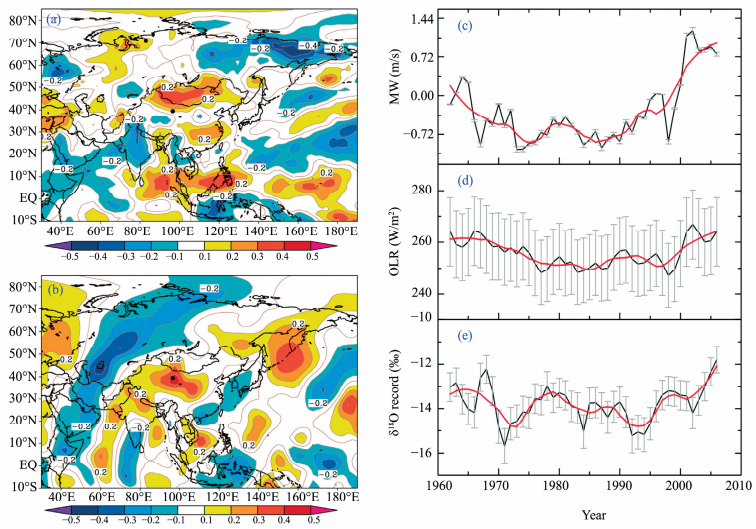
|
| Figure 5 Correlation between LHG δ18O records and climatic variables at 500 hPa from May–September during 1960–2006. Spatial correlations with outgoing longwave radiation (a) and meridional wind time series (b). Comparison among meridional wind, MW (c), outgoing longwave radiation, OLR (d), and LHG δ18O record (e). Error bars represent the standard deviation of the mean at the confidence interval of 95%. |
The OLR is the emission into space of terrestrial radiation from the top of the atmosphere, and it is controlled by the surface temperature of the earth (Susskind et al., 2012). Therefore, we chose the OLR to reflect the thermal condition of the land surface, and to investigate potential mechanisms of δ18O variations in the LHG ice core. The most significant spatial correlation between the OLR and the δ18O records was identified in the Mongolia region (r=0.4, n=47, p < 0.005) (Figure 5a), the temporal data for which was extracted and compared with the δ18O records (Figure 5d). It was found that the greater surface of the OLR in the Mongolia region coincided with the higher LHG δ18O temperature records during the past 47 years, especially after 1980, which is consistent with the beginning of global warming (Kang et al., 2010; You et al., 2010; An et al., 2012). The underlying relationships between OLR and other climatic variables were also explored. The most significant correlations were found with air pressure in the Mongolia region (r=−0.437, n=45, p < 0.002) and with MW in the LHG region (r=0.62, n=45, p < 0.001), indicating that variations of surface OLR could cause changes of air pressure in the Mongolia region, which subsequently might alter MW between the Mongolia region and the LHG region.
3.5 Meridional wind (MW) and δ18O variationsSurface temperature gradients have been highlighted as drivers of low-level atmospheric circulation. In turn, the atmospheric circulation can also influence the variation of air temperature. The large-scale 500 hPa MW can capture the upstream and downstream wave dynamics of the LHG region. We analyzed the spatiotemporal correlation between the 500 hPa MW and the δ18O record and found a prominent positive relationship with summer MW in the LHG region (r=0.43, n=47, p < 0.002) (Figure 5b), which corresponded well with the relationship between surface OLR in the Mongolia region and the LHG δ18O records, and indicated their inherent interaction. The 500 hPa summer MW in the LHG region (the area of greatest correlation) was also extracted for further comparison (Figure 5c). It should be noted that a negative speed of the MW represents southward winds. The variations in MW revealed that the southward wind increased from the mid-1960s to 2000, especially from 1960 to the early 1980s, which corresponded inversely with the annual δ18O records. Around 2000, this switched to a northward wind and it maintained an increasing trend, consistent with the annual variations in the δ18O records, indicating that the MW in the LHG region could have different influences on variations in the δ18O series.
We also investigated the correlations between the MW and the other climatic variables. Positive associations with OLR (r=0.62, n=45, p < 0.001) in the LHG region, and with geopotential height (GH) (r=0.416, n=45, p < 0.005) in the Mongolia region indicated that variations of OLR might change the thermal structure and influence on the GH, and then further dominate the airflow (the MW).
In summer, an extensive anticyclone named the Shulehe High remains over the LHG region (Tang, 1963). During this time the air pressure in the Mongolia region is lower, i.e., the Mongolia Low. Thus, the co-occurrence of the Shulele High and the Mongolia Low could intensify the pressure gradient and push the airflow northward (Ding et al., 2013), which is in accordance with the direction of the MW. The Mongolia Low is intensified by increased OLR, which expands the pressure gradient between the LHG and Mongolia regions and suppresses the southward incursion of cold air across the LHG region, causing rising temperatures. Specifically, the increased southward wind in the Mongolia region prior to 2000 not only reinforced the incursion of cold Arctic air, but it also weakened the northward shift of the westerlies. This strengthened the transport of cold air in the western TP to the LHG region and suppressed the temperature rise because the air temperature in the western TP (rate of increase: 0.09 ℃/decade) was colder than in the eastern TP (rate of increase: 0.21 ℃/decade) (You et al., 2010). Subsequently, a northward wind developed in the Mongolia region that intensified the northward shift of the westerlies, resulting in the attenuation of the transport of colder westerlies to the LHG region and causing temperature rise, which was also discussed by You et al. (2015). The northward shift of the westerlies was conducive to the northward propagation of the Asian summer monsoon, which could bring warm air into the LHG region and enhance the temperature rise since 2000. However, it has also been found that the onset of the Asian summer monsoon is closely related to the reversal of the meridional temperature gradient in the upper troposphere south of the TP, and to warming over the TP (Flohn, 1957; Li and Yanai, 1996). In consideration of the negative relationship between the LHG annual accumulation and OLR in the Mongolia region (Du et al., 2016), this suggests that the OLR in the Mongolia region has an important influence on climate change in the LHG region.
In order to investigate the atmospheric mechanism of temperature rise in the study region since the 1980s, the differences of the 500 hPa summer (June-August) mean flow fields and GH (1985–2006 minus 1960–1984) are presented in Figure 6. It can be seen that the anticyclone in the Mongolia region might have developed the easterly wind, which in turn could have weakened both the eastward penetration of the westerlies and the flow of colder air across the northeastern TP. Meanwhile, the easterly wind over most of the TP brought air from the east to the west, which might have caused the higher temperatures and accelerated the warming between 1985 and 2006 because the temperature in eastern China was higher than in western China (Qin et al., 2016). In addition, the atmospheric circulation in the Mongolia region could affect climate change in the northeastern TP because the higher GH in the Mongolia region would not only block the incursion of Arctic air but also strengthen the transport of eastern air to the LHG region, which might be associated with the drastic temperature rise after the mid-1980s.
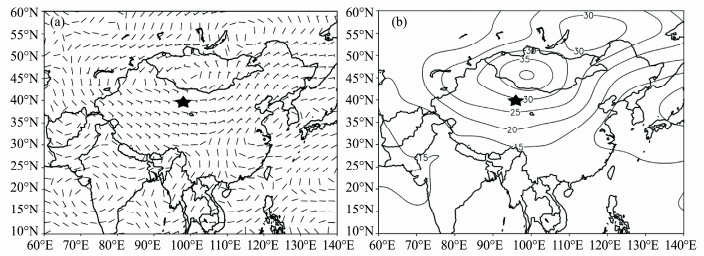
|
| Figure 6 Differences of the summer (June–August) 500 hPa wind field (a) and geopotential height (b) between 1985–2006 and 1960–1984. Data are derived from NCEP/NCAR reanalysis data (available from http://www.cdc.noaa.gov) |
Instrumental observations and the paleoclimate records from climate proxies such as ice cores have indicated that temperatures over the TP have increased significantly in the past 100 years (Yao et al., 2006; Kang et al., 2010; You et al., 2010, 2013). Furthermore, the hiatus in global warming (0.12 ℃/decade) including the low elevation in the nothern TP (0.17 ℃ /decade) since the late 1990s was not observed in the high-elevation regions of the northern TP (An et al., 2016), nor was it found in the δ18O variations in the LHG ice core. Several factors have been considered as contributors to the temperature rise in the TP: anthropogenic greenhouse gas emissions (Chen et al., 2003; Duan et al., 2006), wind stilling (You et al., 2010), increased solar radiation (You et al., 2013), stratospheric ozone depletion (Zhang et al., 2014), changes in cloud amount (Duan and Xiao, 2015), snow-albedo feedback (Liu and Chen, 2000), Asian brown clouds (Ramanathan et al., 2007), and urbanization (You et al., 2009). In this paper, δ18O variations in a 20.12-m ice core retrieved from the LHG Glacier No. 12 were used to reconstruct the historic temperature of the free atmosphere in the northeastern TP. The δ18O variations of precipitation (Hou, 2011), snow pits (Cui et al., 2014), and the LHG ice core were compared with adjacent meteorological temperatures and 500 hPa temperature reanalysis data (NCEP/NCAR), indicating that δ18O is a credible indicator of regional temperature. The δ18O records had distinct positive correlations with summer temperatures (JJA) for the period 1960–1984 and with the temperatures of the warm seasons (MJJAS) during 1985–2006. An abrupt cold temperature event in 1967 and the rapid warming after the 1990s were captured well in the δ18O record, revealing that the δ18O series could record extreme air-temperature events on both regional and global scales. The 500 hPa NCEP/NCAR reanalysis climatic parameters in the warm season were compared with the variations in the LHG δ18O record to investigate the underlying mechanisms, showing that the LHG δ18O records are closely correlated with the summer surface OLR in the Mongolia region and the 500 hPa MW in the LHG region.
Our findings are summarized in the schematic diagram in Figure 7, which illustrates that the Mongolia Low was deeply intensified with the increasing surface OLR in the Mongolia region, and then the pressure gradient between the northeastern TP and the Mongolia region expanded because the Shulehe High always remains in the LHG region in the summer (Tang, 1963). This strengthened the northward airflow and pushed the weakened westerlies farther north, resulting in diminished southward incursion of cold Arctic air into the LHG region. Furthermore, the transport of cold air from central Asia to the LHG region decreased because the air temperature of the western TP (rate of increase: 0.09 ℃/decade) was colder than in the eastern TP (rate of increase: 0.21 ℃/decade) because of their different respective elevations (Frauenfeld et al., 2005).
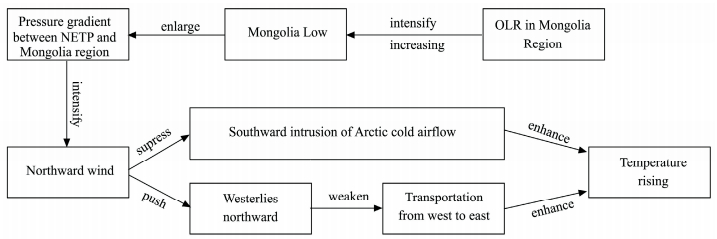
|
| Figure 7 Schematic of LHG δ18O records and climatic variables |
All of these factors promoted the rise of temperature in the northeastern TP during the last four decades (An et al., 2016). Our comparison of regional atmospheric circulation (1985–2006 minus 1960–1984) suggested anticyclone in the Mongolia region might have developed the easterly wind, which transported warmer air from the east toward the LHG region and weakened the cold penetration of the westerlies, resulting in a temperature rise since the middle 1980s. In combination with the relationship between the annual accumulations in the LHG ice core and OLR in Mongolia region (Du et al., 2016), it should be recognized that climatic changes in the northeastern TP have been influenced considerably by the atmospheric circulation in the Mongolia region.
Acknowledgments:This study was supported by the Global Change Research Program of China (No. 2013CBA01801) and the Natural Science Foundation of China (Nos. 41225002, 41371091, and 41121001).
| Alley R, Meese D, Shuman C, et al, 1993. Abrupt increase in Greenland snow accumulation at the end of Younger Dryas event. Nature, 362: 527–529. doi: 10.1038/362527a0 |
| An W, Hou S, Zhang W, et al, 2016. Significant recent warming over the northern Tibetan Plateau from ice core δ18O records. Climate of the Past, 12(2): 201–211. doi: 10.5194/cp-12-201-2016 |
| An Z, Colman SM, Zhou W, et al, 2012. Interplay between the Westerlies and Asian monsoon recorded in Lake Qinghai sed-iments since 32 ka. Science Reports, 2: 619. doi: 10.1038/srep00619 |
| Chen B, Chao WC, Liu X, et al, 2003. Enhanced climatic warming in the Tibetan Plateau due to doubling CO2:a model study. Climate Dynamics, 20: 401–413. doi: 10.1007/s00382-002-0282-4 |
| Craig H, Gordon L, 1965. Deuterium and oxygen-18 in the ocean and marine atmosphere. In:Tongiorgi E (ed.). Stable Isotopes in Oceanographic Studies and Paleotemperatures. Italy:Spoleto, pp. 9-130. Craig H, Gordon L, 1965. Deuterium and oxygen-18 in the ocean and marine atmosphere. In:Tongiorgi E (ed.). Stable Isotopes in Oceanographic Studies and Paleotemperatures. Italy:Spoleto, pp. 9-130. |
| Cui X, Graf HF, 2009. Recent land cover changes on the Tibetan Plateau:a review. Climatic Change, 94: 47–61. doi: 10.1007/s10584-009-9556-8 |
| Cui X, Ren J, Qin X, et al, 2011. Climatic and environmental records within a shallow ice core at Laohugou glacier No. 12, Qilian Mountains. Journal of Glaciology and Geocryology, 33: 1251–1258. |
| Cui X, Ren J, Qin X, et al, 2014. Chemical characteristics and environmental records of a snow-pit at the Glacier No. 12 in the Laohugou Valley, Qilian Mountains. Journal of Earth Science, 25: 379–385. doi: 10.1007/s12583-014-0426-6.(inChinese) |
| Curio J, Maussion F, Scherer D, 2015. A 12-year high-resolution climatology of atmospheric water transport over the Tibetan Plateau earth system. Climatic Dynamics, 6: 109–124. doi: 10.5194/esd-6-109-2015 |
| Daly C, 2006. Guidelines for assessing the suitability of spatial climate data sets. International Journal of Climatology, 26: 707–721. doi: 10.1002/joc.1322 |
| Dansgaard W, 1964. Stable isotopes in precipitation. Tellus (A), 16(4): 436–468. doi: 10.1111/j.2153-3490.1964.tb00181.x |
| Ding Y, Wang S, Zheng J, et al, 2013. Climate in China. Chapter 1:Feature in China. Beijing: Science Press: pp. 17-68. |
| Dong Z, Qin X, Ren J, et al, 2013. A 47-year high resolution chemistry record of atmospheric environment change from the Laohugou Glacier No. 12, north slope of Qilian Mountains, China. Quaternary International, 313: 137–146. |
| Du W, Qin X, Kang S, et al, 2016. Variations in annual accumulation recorded in a Laohugou ice core from the northeastern Tibetan Plateau and their relationship with atmospheric circulation. Environmental Earth Science, 75: 845. doi: 10.1007/s12665-016-5601-x |
| Du W, Qin X, Sun W, et al, 2012. Wind characteristics in accu-mulation area of the Laohugou Glacier No. 12, Qilian Moun-tains. Journal of Glaciology and Geocryology, 34: 29–36. |
| Duan A, Wu G, Zhang Q, et al, 2006. New proofs of the recent climate warming over the Tibetan Plateau as a result of the in-creasing greenhouse gases emissions. Chinese Science Bulletin, 51: 1396–1400. doi: 10.1007/s11434-006-1396-6 |
| Duan A, Xiao Z, 2015. Does the climate warming hiatus exist over the Tibetan Plateau?. Scientific Reports, 5: 13711. doi: 10.1038/srep13711 |
| Flohn H, 1957. Large-scale aspects of the "summer monsoon" in south and east Asia. Journal of Meteorology Society, 75: 180–186. |
| Frauenfeld OW, Zhang T, Serreze MC, 2005. Climate change and variability using European Centre for Medium-Range Weather Forecasts reanalysis (ERA-40) temperatures on the Tibetan Plateau. Journal of Geophysical Research (Atmospheres), 110: D02101. doi: 10.1029/2004JD005230 |
| Gao J, Risi C, Masson-Delmotte V, et al, 2016. Southern Tibetan Plateau ice core δ18O reflects abrupt shifts in atmospheric cir-culation in the late 1970s. Climate Dynamics, 46(1-2): 291–302. doi: 10.1007/s00382-015-2584-3 |
| Hou D, 2011. The application of stable isotopes and geochemical methods on the hydrological processes in the Laohugou Basin. M.S. Thesis, University of Chinese Academy of Sciences, pp. 1-70. (in Chinese) Hou D, 2011. The application of stable isotopes and geochemical methods on the hydrological processes in the Laohugou Basin. M.S. Thesis, University of Chinese Academy of Sciences, pp. 1-70. (in Chinese) |
| Hou S, Qin D, Yao T, et al, 2002. Recent change of the ice core accumulation rates on the Qinghai-Tibetan Plateau. Chinese Science Bulletin, 47(20): 1746–1749. doi: 10.1007/BF03183321 |
| Jia W, He Y, Li Z, et al, 2008. Spatio-temporal distribution char-acteristics of climate change in Qilian Mountains and Hexi Corridor. Journal of Desert Research, 28: 1151–1155. |
| Kang S, 2011. Atmospheric Circulation and Glaciochemical Rec-ords. Encyclopedia of Snow, Ice and Glaciers. Springer, pp. 75-76. DOI:10.1007/978-90-481-2642-2_30. Kang S, 2011. Atmospheric Circulation and Glaciochemical Rec-ords. Encyclopedia of Snow, Ice and Glaciers. Springer, pp. 75-76. DOI:10.1007/978-90-481-2642-2_30. |
| Kang S, Mayewski P, Qin D, et al, 2002. Glaciochemical records from a Mt. Everest ice core:relationship to atmospheric circu-lation over Asia. Atmospheric Environment, 36: 3351–3361. doi: 10.1016/S1352-2310(02)00325-4 |
| Kang S, Mayewski P, Yan Y, et al, 2003. Dust records from three ice cores:relationships to spring atmospheric circulation over the Northern Hemisphere. Atmospheric Environment, 37: 4823–4835. doi: 10.1016/j.atmosenv.2003.08.010 |
| Kang S, Qin D, Ren J, et al, 2007. Annual accumulation in the Mt. Nyainqentanglha ice core, southern Tibetan Plateau, China:relationships to atmospheric circulation over Asia. Arctic, Antarctic, and Alpine Research, 39: 663–670. doi: 10.1657/1523-0430(07503)[KANG]2.0.CO;2 |
| Kang S, Wang F, Morgenstern U, et al, 2015. Dramatic loss of glacier accumulation area on the Tibetan Plateau revealed by ice core tritium and mercury records. The Cryosphere, 9: 1213–1222. doi: 10.5194/tc-9-1213-2015 |
| Kang S, Xu Y, You Q, et al, 2010. Review of climate and cry-ospheric change in the Tibetan Plateau. Environmental Re-search Letters, 5(1): 015101. doi: 10.1088/1748-9326/5/1/015101 |
| Kattel D, Yao T, Yang K, et al, 2013. Temperature lapse rate in complex mountain terrain on the southern slope of the central Himalayas. Theoretical and Applied Climatology, 113: 671–682. doi: 10.1007/s00704-012-0816-6 |
| Landais A, Masson-Delmotte V, Stenni B, et al, 2015. A review of the bipolar see-saw from synchronized and high resolution ice core water stable isotope records from Greenland and East Antarctica. Quaternary Science Reviews, 114: 18–32. doi: 10.1016/j.quascirev.2015.01.031 |
| Li C, Yanai M, 1996. The onset and interannual variability of the Asian summer monsoon in relation to land-sea thermal con-trast. Journal of Climate, 9: 358–375. doi: 10.1175/1520-0442(1996)009<0358:TOAIVO>2.0.CO;2 |
| Liang E, Shao X, Eckstein D, et al, 2010. Spatial variability of tree growth along a latitudinal transect in the Qilian Mountains, northeastern Tibetan Plateau. Canadian Journal of Forest Re-search, 40: 200–211. doi: 10.1139/X09-186 |
| Liu X, Chen B, 2000. Climatic warming in the Tibetan Plateau during recent decades. International Journal of Climatology, 20: 1729–1742. doi: 10.1002/1097-0088(20001130) |
| Molnar P, Boos WR, Battisti DS, 2010. Orographic controls on climate and paleoclimate of Asia:thermal and mechanical roles for the Tibetan Plateau. Annual Review of Earth and Planetary Sciences, 38: 77–102. doi: 10.1146/annurev-earth-040809-152456 |
| Qian Z, Wu T, Liang X, 2001. Feature of mean vertical circulation over the Qinghai-Xizang Plateau and its neighborhood. Chinese Journal of Atmospheric Sciences, 25: 444–454. |
| Qin D, Ding Y, Mu M, 2016. Climate and environmental change in China:1951-2012. Environmental Science and Engineering. Springer, pp. 1-152. Qin D, Ding Y, Mu M, 2016. Climate and environmental change in China:1951-2012. Environmental Science and Engineering. Springer, pp. 1-152. |
| Ramanathan V, Ramana MV, Roberts G, et al, 2007. Warming trends in Asia amplified by brown cloud solar absorption. Na-ture, 448: 575–578. doi: 10.1038/nature06019 |
| Rosen J, Brook E, Severinghaus J, et al, 2014. An ice core record of near-synchronous global climate changes at the Bolling transition. Nature Geoscience, 7: 459–463. doi: 10.1038/ngeo2147 |
| Stahl K, Moore R, Floyer J, et al, 2006. Comparison of approaches for spatial interpolation of daily air temperature in a large region with complex topography and highly variable station density. Agricultural and Forest Meteorology, 139: 224–236. doi: 10.1016/j.agrformet.2006.07.004 |
| Subbaramayya I, Naidu C, 1992. Spatial variations and trends in the Indian monsoon rainfall. International Journal of Climatology, 12: 597–609. doi: 10.1002/joc.3370120606 |
| Sun W, Qin X, Du W, et al, 2014. Ablation modeling and surface energy budget in the ablation zone of Laohugou glacier No. 12, western Qilian mountains, China. Annals of Glaciology, 55: 111–120. doi: 10.3189/2014AoG66A902 |
| Sun W, Qin X, Ren J, et al, 2012. The surface energy budget in the accumulation zone of the Laohugou Glacier No. 12 in the western Qilian Mountains, China, in summer 2009. Arctic, Antarctic, and Alpine Research, 44(3): 296–305. doi: 10.1657/1938-4246-44.3.296 |
| Susskind J, Molnar G, Iredell L, et al, 2012. Interannual variability of outgoing longwave radiation as observed by AIRS and CERES. Journal of Geophysical Research:Atmospheres (1984-2012), 117: D23107. doi: 10.1029/2012JD017997 |
| Takeuchi N, Fujita K, Aizen VB, et al, 2014. The disappearance of glaciers in the Tien Shan Mountains in Central Asia at the end of Pleistocene. Quaternary Science Reviews, 103: 26–33. doi: 10.1016/j.quascirev.2014.09.006 |
| Tang M, 1963. Pressure systems in the mountainous region of western Kansu. Acta Meteorologica Sinica, 2: 175–188. |
| Thompson L, Mosley-Thompson E, Davis E, et al, 2006. Ice core evidence for asynchronous glaciation on the Tibetan Plateau. Quaternary International, 154: 3–10. doi: 10.1016/j.quaint.2006.02.001 |
| Tian L, Masson-Delmotte V, Stievenard M, et al, 2001. Tibetan Plateau summer monsoon northward extent revealed by measurements of water stable isotopes. Journal of Geophysical Research:Atmospheres (1984-2012), 106(D22): 28081–28088. doi: 10.1029/2001JD900186 |
| Tian L, Yao T, Schuster P, et al, 2003. Oxygen-18 concentrations in recent precipitation and ice cores on the Tibetan Plateau. Journal of Geophysical Research:Atmospheres (1984-2012), 108(D9): 469–474. doi: 10.1029/2002JD002173 |
| Vaughan D, Comiso J, Allison I, et al., 2013. Observations:Cry-osphere. In:Climate Change 2013:The Physical Science Basis. Contribution of Working Group I to the Fifth Assessment Re-port of the Intergovernmental Panel on Climate Change. United Kingdom and New York, NY, USA, Cambridge University Press, Cambridge, pp. 317-382. Vaughan D, Comiso J, Allison I, et al., 2013. Observations:Cry-osphere. In:Climate Change 2013:The Physical Science Basis. Contribution of Working Group I to the Fifth Assessment Re-port of the Intergovernmental Panel on Climate Change. United Kingdom and New York, NY, USA, Cambridge University Press, Cambridge, pp. 317-382. |
| Vicente-Serrano SM, Beguería S, López-Moreno JI, et al, 2009. Daily atmospheric circulation events and extreme precipitation risk in northeast Spain:role of the North Atlantic Oscillation, the Western Mediterranean Oscillation, and the Mediterranean Oscillation. Journal of Geophysical Research, 114. doi: 10.1029/2008JD011492 |
| Vimeux F, Gallaire R, Bony S, et al, 2005. What are the climate controls on δD in precipitation in the Zongo Valley (Bolivia)? Implications for the Illimani ice core interpretation. Earth and Planetary Science Letters, 240: 205–220. doi: 10.1016/j.epsl.2005.09.031 |
| Wang N, Thompson L, Davis M, et al, 2003. Influence of varia-tions in NAO and SO on air temperature over the northern Tibetan Plateau as recorded by δ18O in the Malan ice core. Ge-ophysical Research Letters, 30(22): 1–4. doi: 10.1029/2003GL018188 |
| Wu G, Zhang Y, 1998. Tibetan Plateau forcing and the timing of the monsoon onset over South Asia and the South China Sea. Monthly Weather Review, 126: 913–927. doi: 10.1175/1520-0493(1998)126<0913:TPFATT>2.0.CO;2 |
| Yan Z, Jin J, Ye D, 1990. Northern Hemisphere summer climatic jump in the 1960s. I:Variation of precipitation and temperature. Science in China (Series B), 1: 97–103. |
| Yao T, Guo X, Thompson L, et al, 2006. δ18O record and temperature change over the past 100 years in ice cores on the Tibetan Plateau. Science in China (Series D), 49: 1–9. doi: 10.1007/s11430-004-5096-2 |
| Yao T, Masson-Delmotte V, Gao J, et al, 2013. A review of climatic controls on δ18O in precipitation over the Tibetan Plateau:Ob-servations and simulations. Reviews of Geophysics, 51: 525–548. doi: 10.1002/rog.20023 |
| Yao T, Thompson L, Mosley-Thompson E, et al, 1996. Climato-logical significance of δ18O in north Tibetan ice cores. Journal of Geophysical Research:Atmospheres (1984-2012), 101: 29531–29537. doi: 10.1029/96JD02683 |
| Yao T, Thompson L, Yang W, et al, 2012. Different glacier status with atmospheric circulations in Tibetan Plateau and sur-roundings. Nature:Climate Change, 2: 663–667. doi: 10.1038/nclimate1580 |
| Yao T, Thompson LG, 1991. Trends and features of climatic changes in the past 5, 000 years recorded by the Dunde ice core. Annals of Glaciology, 16: 21–24. |
| You Q, Fraedrich K, Ren G, et al, 2012. Inconsistencies of precipitation in the eastern and central Tibetan Plateau between surface adjusted data and reanalysis. Theoretical and Applied Climatology, 109: 485–496. doi: 10.1007/s00704-012-0594-1 |
| You Q, Fraedrich K, Ren G, et al, 2013. Variability of temperature in the Tibetan Plateau based on homogenized surface stations and reanalysis data. International Journal of Climatology, 33: 1337–1347. doi: 10.1002/joc.3512 |
| You Q, Kang S, Flügel WA, et al, 2009. Does a weekend effect in diurnal temperature range exist in the eastern and central Ti-betan Plateau?. Environmental Research Letters, 4: 045202. doi: 10.1088/1748-9326/4/4/045202 |
| You Q, Kang S, Flügel WA, et al, 2010. Decreasing wind speed and weakening latitudinal surface pressure gradients in the Tibetan Plateau. Climate Research, 42: 57–64. doi: 10.3354/cr00864 |
| You Q, Min J, Zhang W, et al, 2015. Comparison of multiple datasets with gridded precipitation observations over the Ti-betan Plateau. Climate Dynamics, 45(3): 791–806. doi: 10.1007/s00382-014-2310-6 |
| Zhang J, Tian W, Xie F, et al, 2014. Climate warming and de-creasing total column ozone over the Tibetan Plateau during winter and spring. Tellus (B), 66: 23415. doi: 10.3402/tellusb.v66.23415 |
| Zhang L, 2006. Research on the water resources and hydrological cycle of the Qilian Mountain. M.S. Thesis, Lanzhou University, Chaper 5:water recycle in Qilian Mountains. Pp. 37-49. (in Chinese) Zhang L, 2006. Research on the water resources and hydrological cycle of the Qilian Mountain. M.S. Thesis, Lanzhou University, Chaper 5:water recycle in Qilian Mountains. Pp. 37-49. (in Chinese) |
| Zhang Y, Hou S, Liu Y, et al, 2012. Preliminary study on the ENSO signal recorded by the δ18O series of ice core from Miaoergou flat-topped glacier, eastern Tienshan. Quaternary Sciences, 32(1): 59–66. doi: 10.3969/j.issn.1001-7410.2012.01.07.(inChinese) |
| Zhang Y, Kang S, Grigholm B, et al, 2016. Twentieth-century warming preserved in a Geladaindong mountain ice core, cen-tral Tibetan Plateau. Annals of Glaciology, 57(71): 70–80. doi: 10.3189/2016AoG71A001 |
| Zhao H, Xu B, Yao T, et al, 2012. Deuterium excess record in a southern Tibetan ice core and its potential climatic implications. Climate Dynamics, 38: 1791–1803. doi: 10.1007/s00382-011-1161-7 |
 2016, 8
2016, 8


